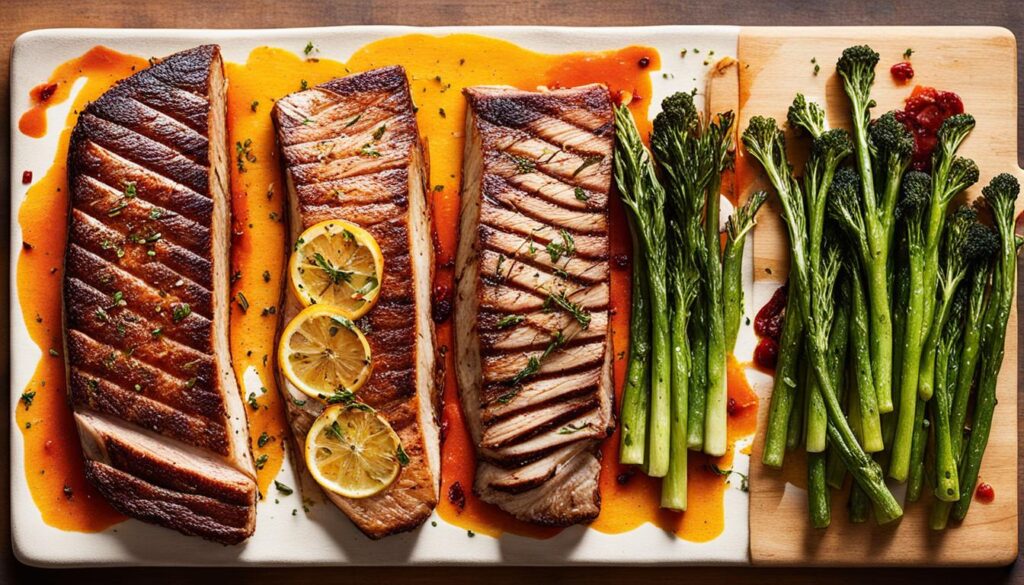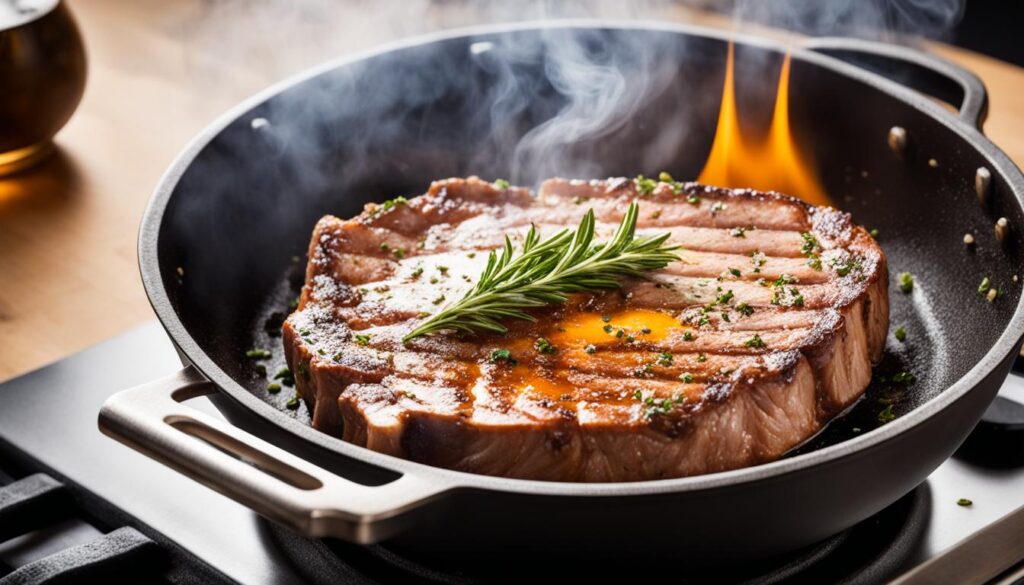Cooking is more than just a hobby; it’s a blend of science, chemistry, and physics. When we heat our food, we start complex chemical reactions and physical changes. These changes affect the taste, texture, and smell of our meals. The Maillard reaction, for example, gives a steak its nice sear, while caramelization makes baked goods sweet.
This article will dive into the science behind what happens in our kitchens. We’ll look at how heat works with our ingredients, showing the chemical reactions that make food tasty and interesting. If you love cooking or just enjoy trying new recipes, get ready for a journey that will change how you see cooking.
Let’s dive into the exciting world of cooking science. Here, physics and chemistry come together to make the tasty meals we enjoy. Get ready to learn the secrets that make cooking so special.
Introduction to the Science of Cooking
Cooking is more than just recipes and techniques. It’s a deep dive into culinary science. When we heat food, we start a chain of chemical and physical changes. These changes shape the flavors, textures, and smells we love.
Understanding the science behind cooking is key to becoming a master chef. From the Maillard reaction to caramelization, each process changes food in unique ways.
Unveiling the Mysteries of Heat and Flavor
Heat and food components work together to create the flavors we love. When we heat food, molecules change, altering their structure. This is where cooking science helps us see how heat and ingredients combine to make flavors.
Understanding the Culinary Transformations
Culinary science reveals the complex changes that happen when we cook. The Maillard reaction, caramelization, and protein denaturation make many dishes rich and savory. By understanding these changes, we can use heat to create amazing dishes.
Exploring culinary science reveals the secrets of delicious flavors and textures. Learning about the Maillard reaction and caramelization changes how we cook. This journey will improve your cooking skills and make your dishes stand out.
The Role of Heat in Cooking
Cooking is more than just following recipes. It’s a dance between ingredients and heat. Heat changes the flavors, textures, and looks of our dishes. From the sizzle of sauté to the crisp crust of a loaf, heat is key in cooking.
Exploring Different Cooking Methods
There are many cooking methods, each with its own way of using heat. Baking uses oven heat to make tender cakes and flaky pastries. Roasting uses high heat to make meats and veggies tasty and caramelized.
Sautéing and stir-frying cook quickly in a pan to keep ingredients bright and crisp. Boiling and simmering cook ingredients slowly in liquid, making them tender.
Each method uses heat differently, giving cooks a wide range of ways to cook. This lets us explore cooking science and make many delicious dishes.

Chemical Reactions in the Kitchen
Cooking is more than just mixing ingredients and heating them. It’s a complex mix of culinary chemistry. Heat, moisture, and other factors trigger chemical reactions that change ingredients at a molecular level. Knowing these reactions is key to cooking well and bringing out the best in your dishes.
The Maillard reaction and caramelization are central to kitchen chemistry. They greatly improve flavor, color, and texture in food. The Maillard reaction happens when proteins and sugars heat up, leading to the tasty browning and savory taste in seared meats and toasted bread. Caramelization, on the other hand, turns sugars into a rich, caramel-like flavor and golden color in baked goods and sauces.
But there’s more to kitchen chemistry. Protein denaturation, or the breaking down of protein structures, changes the texture of cooked meats and eggs. These chemical reactions, along with factors like pH and moisture, turn simple ingredients into delicious meals. By understanding these processes, cooks can create new flavors and textures in their dishes.
Exploring culinary chemistry can make cooking more exciting. Whether you’re cooking a steak, baking a cake, or roasting veggies, knowing the chemical reactions involved helps you control the outcome. So, next time you cook, think of it as a tasty experiment in culinary chemistry.
Maillard Reaction: The Flavor Game-Changer
In the world of cooking, the Maillard reaction is a big deal. It’s a complex process that turns simple foods into something amazing. Think of the rich flavor of a perfectly seared steak or the aroma of freshly baked bread. The Maillard reaction is what makes these foods so delicious.
What Happens During the Maillard Reaction?
The Maillard reaction happens when foods with amino acids and sugars get really hot, above 285°F (140°C). At this heat, these compounds change into new flavors. This is why cooked foods taste so good, from meats to baked goods and coffee.

Achieving the Perfect Sear and Crust
To get the best out of the Maillard reaction, you need to know how to cook. Whether it’s a steak, chicken, or bread, high heat and dry cooking are key. Make sure your food touches a hot surface, like a grill or cast-iron skillet. This way, you can get that perfect sear and flavor that impresses everyone.
Caramelization: The Sweet Science
The world of cooking is full of flavors, and caramelization is a key part of it. This process turns simple ingredients into something special. By understanding caramelization, you can make dishes that are truly amazing.
Unlocking the Caramelized Flavors
Caramelization happens when sugars get really hot, above 230°C (446°F). It breaks down sugars and creates new flavors. These new flavors give foods their golden-brown color and deep taste.
Knowing about caramelization, sugar chemistry, and flavor development is key for great cooking. It lets chefs create dishes that are both delicious and visually appealing.
Whether you’re cooking a steak, roasting veggies, or baking a dessert, caramelization is important. It can make your food taste and look better. By learning about this process, you can become a better cook and make dishes that everyone will love.
Protein Denaturation: Unraveling the Textures
Cooking changes food’s texture in a fascinating way. At the core is protein denaturation, a process that changes the feel and structure of food. By grasping this concept, cooks can make their dishes perfectly textured.
Proteins are key to changing food’s texture. When heated, they change shape, affecting the food’s feel. This is why a steak can be juicy or fish can be flaky.
How much proteins change depends on cooking methods and temperatures. Soft heat makes food tender, while high heat makes it firmer. Chefs use this to get the perfect texture in their dishes.
Learning about cooking science and protein denaturation is exciting. It lets us create amazing meals that please both the body and taste buds. Understanding protein denaturation helps us improve our cooking and make dining special.
Mastering the Culinary Arts
Becoming a skilled chef or home cook is more than just following recipes. It’s about understanding the science behind cooking. This knowledge lets chefs and home cooks create amazing dishes with consistent, innovative, and delicious results.
Embracing the Science of Cooking
Culinary education is not just about learning techniques and recipes. It’s about diving deep into the science of cooking. This includes the chemical and physical changes that happen when we heat ingredients.
For example, the Maillard reaction gives a steak its irresistible crust. Caramelization makes baked goods sweet and complex. These processes are key to making any dish great.
By learning about cooking science, chefs and home cooks can understand how different methods and techniques change a dish. This lets them try new flavors and cooking styles. It leads to more creative and tasty dishes.
Food science also helps cooks make their dishes more consistent and predictable. They can adjust things like temperature and timing better. This ensures their dishes always meet their high standards.
For both seasoned chefs and passionate home cooks, adding cooking science to your skills can change everything. By learning about culinary education, cooking science, and food science applications, you’ll make dishes that are not just delicious but also beautiful and expertly made.
Cooking Temperatures and Doneness Levels
Mastering cooking means understanding how temperature affects food doneness. We’ll explore the science behind cooking temperatures. This ensures your dishes are cooked just right, with the right texture, juiciness, and flavor.
Achieving the Perfect Doneness
Whether you like your steak rare, medium-rare, or well-done, controlling the cooking temperature is key. By keeping an eye on the temperature, you can make dishes that meet your taste.
From searing a juicy ribeye to baking a tender chicken breast, cooking temperatures give you control over your dishes. Learn the best temperature ranges for different doneness levels. Discover how to measure and keep the perfect temperature to improve your cooking.






